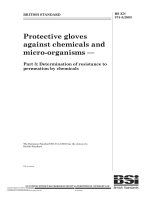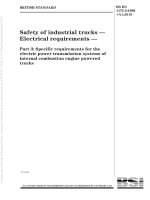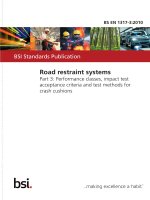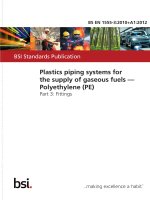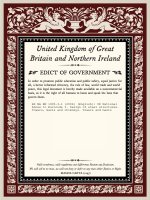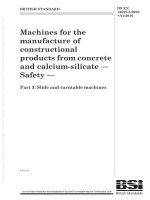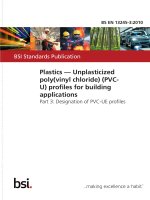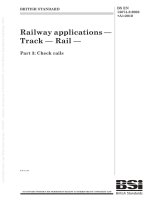Bsi bs en 61784 3 3 2010
Bạn đang xem bản rút gọn của tài liệu. Xem và tải ngay bản đầy đủ của tài liệu tại đây (3.03 MB, 132 trang )
BS EN 61784-3-3:2010
BSI Standards Publication
Industrial communication
networks — Profiles
Part 3-3: Functional safety fieldbuses —
Additional specifications for CPF 3
NO COPYING WITHOUT BSI PERMISSION EXCEPT AS PERMITTED BY COPYRIGHT LAW
raising standards worldwide™
BS EN 61784-3-3:2010 BRITISH STANDARD
National foreword
This British Standard is the UK implementation of EN 61784-3-3:2010.
It is identical to IEC 61784-3-3:2010. It supersedes BS EN
61784-3-3:2008 which is withdrawn.
The UK participation in its preparation was entrusted to Technical
Committee AMT/7, Industrial communications: process measurement
and control, including fieldbus.
A list of organizations represented on this committee can be
obtained on request to its secretary.
This publication does not purport to include all the necessary
provisions of a contract. Users are responsible for its correct
application.
© BSI 2010
ISBN 978 0 580 72029 1
ICS 25.040.40; 35.100.05
Compliance with a British Standard cannot confer immunity from
legal obligations.
This British Standard was published under the authority of the
Standards Policy and Strategy Committee on 30 September 2010.
Amendments issued since publication
Date Text affected
EUROPEAN STANDARD EN 61784-3-3
NORME EUROPÉENNE
EUROPÄISCHE NORM August 2010 Supersedes EN 61784-3-3:2008
ICS 25.040.40; 35.100.05 English version
Industrial communication networks -
Profiles -
Part 3-3: Functional safety fieldbuses -
Additional specifications for CPF 3
(IEC 61784-3-3:2010)
Réseaux de communication industriels - Industrielle Kommunikationsnetze -
Partie 3-3: Bus de terrain à sécurité Profile -
fonctionnelle - Teil 3-3: Funktional sichere Übertragung
Spécifications complémentaires bei Feldbussen -
pour le CPF 3 Zusätzliche Festlegungen
(CEI 61784-3-3:2010) für die Kommunikationsprofilfamilie 3
(IEC 61784-3-3:2010)
This European Standard was approved by CENELEC on 2010-07-01. CENELEC members are bound to comply
with the CEN/CENELEC Internal Regulations which stipulate the conditions for giving this European Standard
the status of a national standard without any alteration.
Up-to-date lists and bibliographical references concerning such national standards may be obtained on
application to the Central Secretariat or to any CENELEC member.
This European Standard exists in three official versions (English, French, German). A version in any other
language made by translation under the responsibility of a CENELEC member into its own language and notified
to the Central Secretariat has the same status as the official versions.
CENELEC members are the national electrotechnical committees of Austria, Belgium, Bulgaria, Croatia, Cyprus,
the Czech Republic, Denmark, Estonia, Finland, France, Germany, Greece, Hungary, Iceland, Ireland, Italy,
Latvia, Lithuania, Luxembourg, Malta, the Netherlands, Norway, Poland, Portugal, Romania, Slovakia, Slovenia,
Spain, Sweden, Switzerland and the United Kingdom.
CENELEC
European Committee for Electrotechnical Standardization
Comité Européen de Normalisation Electrotechnique
Europäisches Komitee für Elektrotechnische Normung
Management Centre: Avenue Marnix 17, B - 1000 Brussels
© 2010 CENELEC - All rights of exploitation in any form and by any means reserved worldwide for CENELEC members.
Ref. No. EN 61784-3-3:2010 E
BS EN 61784-3-3:2010
EN 61784-3-3:2010 - 2 -
Foreword
The text of document 65C/591A/FDIS, future edition 2 of IEC 61784-3-3, prepared by SC 65C, Industrial
networks, of IEC TC 65, Industrial-process measurement, control and automation, was submitted to the
IEC-CENELEC parallel vote and was approved by CENELEC as EN 61784-3-3 on 2010-07-01.
This European Standard supersedes EN 61784-3-3:2008.
The main technical changes with respect to EN 61784-3-3:2008 are listed below:
– updates in relation with changes in EN 61784-3;
– introduction of a secondary watchdog timer (F_WD_Time_2) to cover the use cases
'configuration-in-run', or 'maintenance of fault tolerance systems', or both (7.1.3, 7.2.3, 7.2.6, 8.1.1,
8.1.4, 8.1.6.2);
– missing GSDL definitions conveyed from other approved documents (8.3.2.1);
– missing CRC signature calculation for a GSD conveyed from other approved documents (8.3.3.3);
– constraints for the parameter value assignment of the primary watchdog timer 'F_WD_Time' (9.3.3);
– identification of the safety parameterization state of an F-Device or F-Module via field IM4 (signature)
within the I&M functions (9.6.2);
– updated documents in bibliography.
Attention is drawn to the possibility that some of the elements of this document may be the subject of
patent rights. CEN and CENELEC shall not be held responsible for identifying any or all such patent
rights.
The following dates were fixed:
– latest date by which the EN has to be implemented (dop) 2011-04-01
at national level by publication of an identical
national standard or by endorsement
– latest date by which the national standards conflicting (dow) 2013-07-01
with the EN have to be withdrawn
Annex ZA has been added by CENELEC. __________
- 3 - BS EN 61784-3-3:2010
EN 61784-3-3:2010
Endorsement notice
The text of the International Standard IEC 61784-3-3:2010 was approved by CENELEC as a European
Standard without any modification.
In the official version, for Bibliography, the following notes have to be added for the standards indicated:
IEC 60870-5-1 NOTE Harmonized as EN 60870-5-1.
IEC 61158 series NOTE Harmonized in EN 61158 series (not modified).
IEC 61496 series NOTE Harmonized in EN 61496 series (partially modified).
IEC 61508-1:2010 NOTE Harmonized as EN 61508-1:2010 (not modified).
IEC 61508-4:2010 NOTE Harmonized as EN 61508-4:2010 (not modified).
IEC 61508-5:2010 NOTE Harmonized as EN 61508-5:2010 (not modified).
IEC 61508-6:2010 NOTE Harmonized as EN 61508-6:2010 (not modified).
IEC 61784-5 series NOTE Harmonized in EN 61784-5 series (not modified).
IEC 61800-5-2 NOTE Harmonized as EN 61800-5-2.
IEC 61804 series NOTE Harmonized in EN 61804 series (not modified).
ISO 10218-1 NOTE Harmonized as EN ISO 10218-1.
ISO 12100-1 NOTE Harmonized as EN ISO 12100-1.
__________
BS EN 61784-3-3:2010
EN 61784-3-3:2010 - 4 -
Annex ZA
(normative)
Normative references to international publications
with their corresponding European publications
The following referenced documents are indispensable for the application of this document. For dated
references, only the edition cited applies. For undated references, the latest edition of the referenced
document (including any amendments) applies.
NOTE When an international publication has been modified by common modifications, indicated by (mod), the relevant EN/HD
applies.
Publication Year Title EN/HD Year
IEC 60204-1 - -
IEC 61000-6-2 - Safety of machinery - Electrical equipment of EN 60204-1 -
IEC 61010-1 - machines - -
IEC 61131-2 - Part 1: General requirements -
IEC 61131-3 - -
IEC 61158-2 - Electromagnetic compatibility (EMC) - EN 61000-6-2 -
Part 6-2: Generic standards - Immunity for
IEC 61158-3-3 - industrial environments -
IEC 61158-4-3 - Safety requirements for electrical equipment EN 61010-1 -
for measurement, control and laboratory use -
IEC 61158-5-3 - Part 1: General requirements -
IEC 61158-5-10 - Programmable controllers - EN 61131-2 -
Part 2: Equipment requirements and tests
IEC 61158-6-3 - -
Programmable controllers - EN 61131-3
Part 3: Programming languages -
Industrial communication networks - EN 61158-2
Fieldbus specifications -
Part 2: Physical layer specification and service
definition
Industrial communication networks - EN 61158-3-3
Fieldbus specifications -
Part 3-3: Data-link layer service definition -
Type 3 elements
Industrial communication networks - EN 61158-4-3
Fieldbus specifications -
Part 4-3: Data-link layer protocol specification
- Type 3 elements
Industrial communication networks - EN 61158-5-3
Fieldbus specifications -
Part 5-3: Application layer service definition -
Type 3 elements
Industrial communication networks - EN 61158-5-10
Fieldbus specifications -
Part 5-10: Application layer service definition -
Type 10 elements
Industrial communication networks - EN 61158-6-3
Fieldbus specifications -
Part 6-3: Application layer protocol
specification - Type 3 elements
- 5 - BS EN 61784-3-3:2010
EN 61784-3-3:2010
Publication Year Title EN/HD Year
IEC 61158-6-10 - -
IEC 61326-3-1 - Industrial communication networks - EN 61158-6-10 -
Fieldbus specifications -
IEC 61326-3-2 - Part 6-10: Application layer protocol -
specification - Type 10 elements
IEC 61508 Series Series
IEC 61508-2 - Electrical equipment for measurement, EN 61326-3-1 -
IEC 61511 Series control and laboratory use - EMC Series
IEC 61784-1 - -
IEC 61784-2 - requirements - -
IEC 61784-3 2010 2010
IEC 61784-5-3 - Part 3-1: Immunity requirements for safety- -
IEC 61918 - -
IEC 62061 - related systems and for equipment intended to -
IEC 62280-1 2002 -
perform safety-related functions (functional
safety) - General industrial applications
Electrical equipment for measurement, EN 61326-3-2
control and laboratory use - EMC
requirements -
Part 3-2: Immunity requirements for safety-
related systems and for equipment intended to
perform safety-related functions (functional
safety) - Industrial applications with specified
electromagnetic environment
Functional safety of EN 61508
electrical/electronic/programmable electronic
safety-related systems
Functional safety of EN 61508-2
electrical/electronic/programmable electronic
safety-related systems -
Part 2: Requirements for
electrical/electronic/programmable electronic
safety-related systems
Functional safety - Safety instrumented EN 61511
systems for the process industry sector
Industrial communication networks - Profiles - EN 61784-1
Part 1: Fieldbus profiles
Industrial communication networks - Profiles - EN 61784-2
Part 2: Additional fieldbus profiles for real-time
networks based on ISO/IEC 8802-3
Industrial communication networks - Profiles - EN 61784-3
Part 3: Functional safety fieldbuses - General
rules and profile definitions
Industrial communication networks - Profiles - EN 61784-5-3
Part 5-3: Installation of fieldbuses - Installation
profiles for CPF 3
Industrial communication networks - EN 61918
Installation of communication networks in
industrial premises
Safety of machinery - Functional safety of EN 62061
safety-related electrical, electronic and
programmable electronic control systems
Railway applications - Communication, -
signalling and processing systems -
Part 1: Safety-related communication in
closed transmission systems
BS EN 61784-3-3:2010
EN 61784-3-3:2010 - 6 -
Publication Year Title EN/HD Year
IEC 62280-2 - - -
Railway applications - Communication,
IEC/TR 62390 - signalling and processing systems - - -
ISO 13849-1 - Part 2: Safety-related communication in open EN ISO 13849-1 -
ISO 13849-2 - transmission systems EN ISO 13849-2 -
ISO 15745-3 - - -
Common automation device -
ISO 15745-4 - Profile guideline - -
Safety of machinery - Safety-related parts of
control systems -
Part 1: General principles for design
Safety of machinery - Safety-related parts of
control systems -
Part 2: Validation
Industrial automation systems and
integration - Open systems application
integration framework -
Part 3: Reference description for IEC 61158
based control systems
Industrial automation systems and
integration - Open systems application
integration framework -
Part 4: Reference description for Ethernet-
based control systems
–4– BS EN 61784-3-3:2010
61784-3-3 © IEC:2010(E)
CONTENTS
0 Introduction .................................................................................................................... 10
0.1 General .................................................................................................................10
0.2 Patent declaration .................................................................................................12
1 Scope............................................................................................................................. 13
2 Normative references .....................................................................................................13
3 Terms, definitions, symbols, abbreviated terms and conventions .................................... 15
3.1 Terms and definitions ............................................................................................15
3.1.1 Common terms and definitions ..................................................................15
3.1.2 CPF 3: Additional terms and definitions .....................................................20
3.2 Symbols and abbreviated terms............................................................................. 23
3.2.1 Common symbols and abbreviated terms .................................................. 23
3.2.2 CPF 3: Additional symbols and abbreviated terms ..................................... 24
3.3 Conventions ..........................................................................................................25
4 Overview of FSCP 3/1 (PROFIsafe™) ............................................................................25
5 General .......................................................................................................................... 28
5.1 External documents providing specifications for the profile ....................................28
5.2 Safety functional requirements ..............................................................................28
5.3 Safety measures ...................................................................................................29
5.4 Safety communication layer structure ....................................................................30
5.4.1 Principle of FSCP 3/1 safety communications ............................................ 30
5.4.2 CPF 3 communication structures ...............................................................31
5.5 Relationships with FAL (and DLL, PhL) .................................................................34
5.5.1 Device model.............................................................................................34
5.5.2 Application and communication relationships............................................. 34
5.5.3 Message format.........................................................................................36
5.5.4 Data types .................................................................................................36
6 Safety communication layer services ..............................................................................37
6.1 F-Host services .....................................................................................................37
6.2 F-Device services..................................................................................................39
6.3 Diagnosis ..............................................................................................................41
6.3.1 Safety alarm generation.............................................................................41
6.3.2 F-Device safety layer diagnosis including the iPar-Server.......................... 41
7 Safety communication layer protocol ..............................................................................42
7.1 Safety PDU format ................................................................................................42
7.1.1 Safety PDU structure .................................................................................42
7.1.2 Safety I/O data ..........................................................................................43
7.1.3 Status and Control Byte............................................................................. 43
7.1.4 (Virtual) Consecutive Number ....................................................................44
7.1.5 CRC2 Signature ........................................................................................46
7.1.6 Appended standard I/O data ......................................................................47
7.2 FSCP 3/1 behavior ................................................................................................47
7.2.1 General .....................................................................................................47
7.2.2 F-Host state diagram .................................................................................47
7.2.3 F-Device state diagram..............................................................................51
7.2.4 Sequence diagrams ...................................................................................55
BS EN 61784-3-3:2010 – 5 –
61784-3-3 © IEC:2010(E)
7.2.5 Timing diagram for a counter reset ............................................................61
7.2.6 Monitoring of safety times..........................................................................61
7.3 Reaction in the event of a malfunction ...................................................................64
7.3.1 Repetition ..................................................................................................64
7.3.2 Loss ..........................................................................................................65
7.3.3 Insertion ....................................................................................................65
7.3.4 Incorrect sequence ....................................................................................65
7.3.5 Corruption of safety data ...........................................................................65
7.3.6 Delay.........................................................................................................66
7.3.7 Masquerade ..............................................................................................66
7.3.8 Memory failures within switches ................................................................66
7.3.9 Network boundaries and router ..................................................................67
7.4 F-Startup and change coordination........................................................................68
7.4.1 Standard startup procedure .......................................................................68
7.4.2 iParameter assignment deblocking ............................................................68
8 Safety communication layer management.......................................................................69
8.1 F-Parameter ..........................................................................................................69
8.1.1 Summary ...................................................................................................69
8.1.2 F_Source/Destination_Address (codename) ..............................................69
8.1.3 F_WD_Time (F-Watchdog time)................................................................. 69
8.1.4 F_WD_Time_2 (secondary F-Watchdog time) ............................................ 70
8.1.5 F_Prm_Flag1 (Parameters for the safety layer management) .................... 70
8.1.6 F_Prm_Flag2 (Parameters for the safety layer management) .................... 72
8.1.7 F_iPar_CRC (value of iPar_CRC across iParameters) ...............................73
8.1.8 F_Par_CRC (CRC1 across F-Parameters) .................................................73
8.1.9 Structure of the F-Parameter record data object ........................................74
8.1.10 F-Data fraction ..........................................................................................74
8.2 iParameter and iPar_CRC .....................................................................................74
8.3 Safety parameterization.........................................................................................75
8.3.1 Objectives .................................................................................................75
8.3.2 GSDL and GSDML safety extensions.........................................................76
8.3.3 Securing safety parameters and GSD data ................................................77
8.4 Safety configuration ..............................................................................................80
8.4.1 Securing the safety I/O data description (CRC7)........................................ 80
8.4.2 DataItem data type section examples ........................................................ 81
8.5 Data type information usage .................................................................................. 84
8.5.1 F-Channel driver........................................................................................84
8.5.2 Rules for standard F-Channel drivers ........................................................85
8.5.3 Recommendations for F-Channel drivers ...................................................86
8.6 Safety parameter assignment mechanisms............................................................87
8.6.1 F-Parameter assignment ...........................................................................87
8.6.2 General iParameter assignment.................................................................87
8.6.3 System integration requirements for iParameterization tools...................... 88
8.6.4 iPar-Server ................................................................................................90
9 System requirements...................................................................................................... 99
9.1 Indicators and switches .........................................................................................99
9.2 Installation guidelines............................................................................................99
9.3 Safety function response time ...............................................................................99
9.3.1 Model ........................................................................................................99
– 6 – BS EN 61784-3-3:2010
61784-3-3 © IEC:2010(E)
9.3.2 Calculation and optimization .................................................................... 101
9.3.3 Adjustment of watchdog times for FSCP 3/1 ............................................ 103
9.3.4 Engineering tool support.......................................................................... 104
9.3.5 Retries (repetition of messages) .............................................................. 104
9.4 Duration of demands ........................................................................................... 105
9.5 Constraints for the calculation of system characteristics ...................................... 106
9.5.1 Probabilistic considerations ..................................................................... 106
9.5.2 Safety related constraints ........................................................................ 108
9.5.3 Non safety related constraints (availability).............................................. 109
9.6 Maintenance........................................................................................................ 109
9.6.1 F-Module commissioning / replacement ................................................... 109
9.6.2 Identification and maintenance functions ................................................. 109
9.7 Safety manual ..................................................................................................... 110
9.8 Wireless transmission channels........................................................................... 111
9.8.1 Black channel approach .......................................................................... 111
9.8.2 Availability............................................................................................... 111
9.8.3 Security measures ................................................................................... 111
9.8.4 Stationary and mobile applications .......................................................... 113
9.9 Conformance classes .......................................................................................... 113
10 Assessment.................................................................................................................. 114
10.1 Safety policy ....................................................................................................... 114
10.2 Obligations .......................................................................................................... 115
Annex A (informative) Additional information for functional safety communication
profiles of CPF 3................................................................................................................. 116
A.1 Hash function calculation.............................................................................................. 116
A.2 Response time measurements...................................................................................... 118
Annex B (informative) Information for assessment of the functional safety
communication profiles of CPF 3 ........................................................................................ 122
Bibliography........................................................................................................................ 123
Table 1 – Deployed measures to master errors ..................................................................... 29
Table 2 – Data types used for FSCP 3/1 ............................................................................... 36
Table 3 – Safety layer diagnosis messages .......................................................................... 41
Table 4 – F-Host states and transitions.................................................................................49
Table 5 – F-Device states and transitions .............................................................................53
Table 6 – SIL monitor times ..................................................................................................64
Table 7 – Remedies for switch failures..................................................................................67
Table 8 – Safety network boundaries ....................................................................................68
Table 9 — GSDL keywords for F-Parameters and F-I/O structures........................................76
Table 10 – I/O data structure items (Version 2) .....................................................................80
Table 11 – Sample F-Channel drivers ...................................................................................85
Table 12 – Requirements for iParameterization.....................................................................88
Table 13 – Specifier for the iPar-Server Request .................................................................. 92
Table 14 – Structure of the Read_RES_PDU ("read record")................................................. 94
Table 15 – Structure of the Write_REQ_PDU ("write record")................................................ 95
Table 16 – Structure of the Pull_RES_PDU ("Pull")...............................................................95
BS EN 61784-3-3:2010 – 7 –
61784-3-3 © IEC:2010(E)
Table 17 – Structure of the Push_REQ_PDU ("Push") .......................................................... 95
Table 18 – iPar-Server states and transitions........................................................................97
Table 19 – iPar-Server management measures.....................................................................98
Table 20 – Information to be included in the safety manual ................................................. 110
Table 21 – Security measures for WLAN (IEEE 802.11i) ..................................................... 112
Table 22 – Security measures for Bluetooth (IEEE 802.15.1) .............................................. 113
Table 23 – F-Host conformance class requirements............................................................ 114
Table A.1 – The table "Crctab24" for 24 bit CRC signature calculations .............................. 117
Table A.2 – The table "Crctab32" for 32 bit CRC signature calculations .............................. 118
Figure 1 – Relationships of IEC 61784-3 with other standards (machinery) ........................... 10
Figure 2 – Relationships of IEC 61784-3 with other standards (process) ...............................11
Figure 3 – Basic communication preconditions for FSCP 3/1 ................................................26
Figure 4 – Structure of an FSCP 3/1 safety PDU...................................................................27
Figure 5 – Safety communication modes...............................................................................28
Figure 6 – Standard CPF 3 transmission system ................................................................... 30
Figure 7 – Safety layer architecture ...................................................................................... 31
Figure 8 – Basic communication layers ................................................................................. 31
Figure 9 – Multiport switch bus structure...............................................................................32
Figure 10 – Linear bus structure ...........................................................................................32
Figure 11 – Crossing network borders with routers ...............................................................33
Figure 12 – Complete safety transmission paths ...................................................................33
Figure 13 – Device model .....................................................................................................34
Figure 14 – Application relationships of a modular device ..................................................... 35
Figure 15 – Application and communication relationships (AR/CR) ....................................... 35
Figure 16 – Message format .................................................................................................36
Figure 17 – FSCP 3/1 communication structure ....................................................................37
Figure 18 – F user interface of F-Host driver instances .........................................................38
Figure 19 – F-Device driver interfaces ..................................................................................40
Figure 20 – Safety PDU for CPF 3 ........................................................................................42
Figure 21 – Status Byte ........................................................................................................43
Figure 22 – Control Byte .......................................................................................................44
Figure 23 – The Toggle Bit function ......................................................................................45
Figure 24 – F-Device Consecutive Number ...........................................................................45
Figure 25 – CRC2 generation (F-Host output) .......................................................................46
Figure 26 – Details of the CRC2 calculation (reverse order).................................................. 47
Figure 27 – Safety layer communication relationship............................................................. 47
Figure 28 – F-Host state diagram..........................................................................................48
Figure 29 – F-Device state diagram ......................................................................................52
Figure 30 – Interaction F-Host / F-Device during start-up ......................................................55
Figure 31 – Interaction F-Host / F-Device during F-Host power off → on ...............................56
Figure 32 – Interaction F-Host / F-Device with delayed power on ..........................................57
– 8 – BS EN 61784-3-3:2010
61784-3-3 © IEC:2010(E)
Figure 33 – Interaction F-Host / F-Device during power off → on ..........................................58
Figure 34 – Interaction F-Host / F-Device while host recognizes CRC error ..........................59
Figure 35 – Interaction F-Host / F-Device while device recognizes CRC error .......................60
Figure 36 – Impact of the counter reset signal ......................................................................61
Figure 37 – Monitoring the message transit time F-Host ↔ F-Output ....................................62
Figure 38 – Monitoring the message transit time F-Input ↔ F-Host .......................................62
Figure 39 – Extended watchdog time on request ...................................................................64
Figure 40 – F-Parameter data and CRC ................................................................................65
Figure 41 – iParameter assignment deblocking by the F-Host ............................................... 68
Figure 42 – Effect of F_WD_Time_2 .....................................................................................70
Figure 43 – F_Prm_Flag1 .....................................................................................................70
Figure 44 – F_Check_SeqNr .................................................................................................71
Figure 45 – F_Check_iPar ....................................................................................................71
Figure 46 – F_SIL ................................................................................................................. 71
Figure 47 – F_CRC_Length ..................................................................................................72
Figure 48 – F_Prm_Flag2 .....................................................................................................72
Figure 49 – F_Block_ID ........................................................................................................72
Figure 50 – F_Par_Version ...................................................................................................73
Figure 51 – F-Parameter.......................................................................................................74
Figure 52 – iParameter block ................................................................................................75
Figure 53 – F-Parameter extension within the GSDML specification...................................... 77
Figure 54 – CRC1 including iPar_CRC..................................................................................78
Figure 55 – Algorithm to build CRC0 (GSDL) ........................................................................79
Figure 56 – Algorithm to build CRC0 (GSDML) .....................................................................80
Figure 57 – DataItem section for F_IN_OUT_1......................................................................82
Figure 58 – DataItem section for F_IN_OUT_2......................................................................83
Figure 59 – DataItem section for F_IN_OUT_5......................................................................83
Figure 60 – DataItem section for F_IN_OUT_6......................................................................84
Figure 61 – F-Channel driver as "glue" between F-Device and user program ........................85
Figure 62 – Layout example of an F-Channel driver .............................................................. 86
Figure 63 – F-Parameter assignment for simple F-Devices and F-Slaves .............................. 87
Figure 64 – F and iParameter assignment for complex F-Devices .........................................88
Figure 65 – System integration of CPD-Tools........................................................................ 89
Figure 66 – iPar-Server mechanism (commissioning)............................................................ 90
Figure 67 – iPar-Server mechanism (for example F-Device replacement) ............................. 91
Figure 68 – iPar-Server request coding ("status model") ....................................................... 92
Figure 69 – Coding of SR_Type ............................................................................................ 93
Figure 70 – iPar-Server request coding ("alarm model")........................................................ 94
Figure 71 – iPar-Server state diagram ..................................................................................96
Figure 72 – Example safety function with a critical response time path ............................... 100
Figure 73 – Simplified typical response time model............................................................. 100
Figure 74 – Frequency distributions of typical response times of the model ........................ 101
Figure 75 – Context of delay times and watchdog times ...................................................... 102
BS EN 61784-3-3:2010 – 9 –
61784-3-3 © IEC:2010(E)
Figure 76 – Timing sections forming the FSCP 3/1 F_WD_Time ......................................... 103
Figure 77 – Frequency distribution of response times with message retries ........................ 104
Figure 78 – Retries with CP 3/1 .......................................................................................... 105
Figure 79 – Retries with CP 3/RTE ..................................................................................... 105
Figure 80 – Residual error probabilities for the 24-bit polynomial ........................................ 106
Figure 81 – Properness of the 32-bit polynomial for 52 octets ............................................. 107
Figure 82 – Properness of the 32-bit polynomial for 132 octets ........................................... 107
Figure 83 – Monitoring of corrupted messages.................................................................... 108
Figure 84 – Security for WLAN networks............................................................................. 111
Figure 85 – Security for Bluetooth networks........................................................................ 112
Figure A.1 – Typical "C" procedure of a cyclic redundancy check........................................ 116
Figure A.2 – Comparison of the response time model and a real application ....................... 119
Figure A.3 – Frequency distribution of measured response times........................................ 120
Figure A.4 – F-Host with standard and safety-related application programs ........................ 121
– 10 – BS EN 61784-3-3:2010
61784-3-3 © IEC:2010(E)
0 Introduction
0.1 General
The IEC 61158 fieldbus standard together with its companion standards IEC 61784-1 and
IEC 61784-2 defines a set of communication protocols that enable distributed control of
automation applications. Fieldbus technology is now considered well accepted and well
proven. Thus many fieldbus enhancements are emerging, addressing not yet standardized
areas such as real time, safety-related and security-related applications.
This standard explains the relevant principles for functional safety communications with
reference to IEC 61508 series and specifies several safety communication layers (profiles and
corresponding protocols) based on the communication profiles and protocol layers of
IEC 61784-1, IEC 61784-2 and the IEC 61158 series. It does not cover electrical safety and
intrinsic safety aspects.
Figure 1 shows the relationships between this standard and relevant safety and fieldbus
standards in a machinery environment.
Product standards IISSOO 1122110000--11 aanndd IISSOO 1144112211
IIEECC 6611449966 IIEECC 6611113311--66 IIEECC 6611880000--55--22 IISSOO 1100221188--11 SSaaffeettyy ooff mmaacchhiinneerryy –– PPrriinncciipplleess ffoorr
ddeessiiggnnaannddrriisskk aasssseessssmmeenntt
SSaaffeettyyff.. ee..gg.. SSaaffeettyyffoorrPPLLCC SSaaffeettyyffuunnccttiioonnss SSaaffeettyyrreeqquuiirreemmeennttss
lliigghhtt ccuurrttaaiinnss ffoorr ddrriivveess ffoorr rroobboottss
((uunnddeerrccoonnssidideerraattioionn))
IIEECC 6611778844--44 IIEECC 6622444433 Design of safety-related electrical, electronic and program-
mable electronic control systems (SRECS) for machinery
SSeeccuurriittyy SSeeccuurriittyy
((pprrooffiillee--ssppeecciiffiicc)) ((ccoommmmoonnppaarrtt)) SIL based PL based
IIEECC 6611778844--55 IIEECC 6611991188 Design objective
Applicable standards
IInnssttaallllaattiioonn gguuiiddee IInnssttaallllaattiioonn gguuiiddee
((pprrooffiillee--ssppeecciiffiicc)) ((ccoommmmoonnppaarrtt)) IIEECC 6600220044--11 IISSOO 1133884499--11,, --22
IIEECC 6611778844--33 IIEECC 6611000000--11--22 SSaaffeettyyooff eelleeccttrriiccaall SSaaffeettyy--rreellaatteeddppaarrttss
eeqquuiippmmeenntt ooff mmaacchhiinneerryy
FFuunnccttiioonnaall ssaaffeettyy MMeetthhooddoollooggyyEEMMCC&&FFSS ((SSRRPPCCSS))
ccoommmmuunniiccaattiioonn UUSS:: NNFFPPAA 7799 NNoonn--eelleeccttrriiccaall
IIEECC 6611332266--33--11 ((22000066)) EElleeccttrriiccaall
pprrooffiilleess
TTeesstt EEMMCC && FFSS
IIEECC 6611115588 sseerriieess // IIEECC 6611550088 sseerriieess IIEECC 6622006611
IIEECC 6611778844--11,,--22
FFuunnccttiioonnaall ssaaffeettyy ((FFSS)) FFuunnccttiioonnaall ssaaffeettyy
FFiieellddbbuuss ffoorr uussee iinn ((bbaassiicc ssttaannddaarrdd)) ffoorr mmaacchhiinneerryy
iinndduussttrriiaall ccoonnttrrooll ssyysstteemmss ((SSRREECCSS))
((iinncclluuddiinngg EEMMCCffoorr
iinndduussttrriiaall eennvviirroonnmmeenntt))
Key
(yellow) safety-related standards
(blue) fieldbus-related standards
(dashed yellow) this standard
NOTE Subclauses 6.7.6.4 (high complexity) and 6.7.8.1.6 (low complexity) of IEC 62061 specify the relationship
between PL (Category) and SIL.
Figure 1 – Relationships of IEC 61784-3 with other standards (machinery)
BS EN 61784-3-3:2010 – 11 –
61784-3-3 © IEC:2010(E)
Figure 2 shows the relationships between this standard and relevant safety and fieldbus
standards in a process environment.
Product standards
IIEECC 6611449966 IIEECC 6611113311--66 IIEECC 6611880000--55--22 IISSOO 1100221188--11
SSaaffeettyy ff.. ee..gg.. SSaaffeettyy ffoorr PPLLCC SSaaffeettyyffuunnccttiioonnss SSaaffeettyy rreeqquuiirreemmeennttss
lliigghhtt ccuurrttaaiinnss ffoorr ddrriivveess ffoorr rroobboottss
((uunnddeerrccoonnssidideerraattioionn))
IIEECC 6611778844--44 IIEECC 6622444433 See safety standards for machinery
(Figure 1)
SSeeccuurriittyy SSeeccuurriittyy
((pprrooffiillee--ssppeecciiffiicc)) ((ccoommmmoonn ppaarrtt)) Valid also in process industries,
whenever applicable
IIEECC 6611778844--55 IIEECC 6611991188
IInnssttaallllaattiioonngguuiiddee IInnssttaallllaattiioonngguuiiddee
((pprrooffiillee--ssppeecciiffiicc)) ((ccoommmmoonn ppaarrtt))
IIEECC 6611778844--33 IIEECC 6611332266--33--22aa))
FFuunnccttiioonnaall ssaaffeettyy EEMMCC aanndd
ccoommmmuunniiccaattiioonn ffuunnccttiioonnaall ssaaffeettyy
pprrooffiilleess
IIEECC 6611115588 sseerriieess // IIEECC 6611550088 sseerriieess IIEECC 6611551111 sseerriieessbb)) UUSS::
IIEECC 6611778844--11,,--22
FFuunnccttiioonnaall ssaaffeettyy((FFSS)) FFuunnccttiioonnaall ssaaffeettyy–– IISSAA--8844..0000..0011
FFiieellddbbuuss ffoorr uussee iinn ((bbaassiicc ssttaannddaarrdd)) SSaaffeettyy iinnssttrruummeenntteedd
iinndduussttrriiaallccoonnttrrooll ssyysstteemmss ((33 ppaarrttss == mmooddiiffiieedd
ssyysstteemmss ffoorr tthhee IIEECC 6611551111))
pprroocceessss iinndduussttrryy sseeccttoorr
DDEE:: VVDDII 22118800
PPaarrtt 11--44
Key
(yellow) safety-related standards
(blue) fieldbus-related standards
(dashed yellow) this standard
a For specified electromagnetic environments; otherwise IEC 61326-3-1.
b EN ratified.
Figure 2 – Relationships of IEC 61784-3 with other standards (process)
Safety communication layers which are implemented as parts of safety-related systems
according to IEC 61508 series provide the necessary confidence in the transportation of
messages (information) between two or more participants on a fieldbus in a safety-related
system, or sufficient confidence of safe behaviour in the event of fieldbus errors or failures.
Safety communication layers specified in this standard do this in such a way that a fieldbus
can be used for applications requiring functional safety up to the Safety Integrity Level (SIL)
specified by its corresponding functional safety communication profile.
The resulting SIL claim of a system depends on the implementation of the selected functional
safety communication profile within this system – implementation of a functional safety
communication profile in a standard device is not sufficient to qualify it as a safety device.
– 12 – BS EN 61784-3-3:2010
61784-3-3 © IEC:2010(E)
This standard describes:
⎯ basic principles for implementing the requirements of IEC 61508 series for safety-
related data communications, including possible transmission faults, remedial
measures and considerations affecting data integrity;
⎯ individual description of functional safety profiles for several communication profile
families in IEC 61784-1 and IEC 61784-2;
⎯ safety layer extensions to the communication service and protocols sections of the
IEC 61158 series.
0.2 Patent declaration
The International Electrotechnical Commission (IEC) draws attention to the fact that it is
claimed that compliance with this document may involve the use of patents concerning the
functional safety communication profiles for family 3 as follows, where the [xx] notation
indicates the holder of the patent right:
EP1267270-A2 [SI] Method for data transfer
WO00/045562-A1 [SI] Method and device for determining the reliability of
data carriers
WO99/049373-A1 [SI] Shortened data message of an automation system
EP1686732 [SI] Method and system for transmitting protocol data units
EP1802019 [SI] Identification of errors in data transmission
EP1921525-A1 [SI] Method for operation of a safety-related system
IEC takes no position concerning the evidence, validity and scope of these patent rights.
The holders of these patents rights have assured the IEC that they are willing to negotiate
licences under reasonable and non-discriminatory terms and conditions with applicants
throughout the world. In this respect, the statement of the holders of these patent rights are
registered with IEC.
Information may be obtained from:
[SI] Siemens AG
I IA AS FA TC
76187 Karlsruhe
GERMANY
Attention is drawn to the possibility that some of the elements of this document may be the
subject of patent rights other than those identified above. IEC shall not be held responsible for
identifying any or all such patent rights.
BS EN 61784-3-3:2010 – 13 –
61784-3-3 © IEC:2010(E)
INDUSTRIAL COMMUNICATION NETWORKS –
PROFILES –
Part 3-3: Functional safety fieldbuses –
Additional specifications for CPF 3
1 Scope
This part of the IEC 61784-3 series specifies a safety communication layer (services and
protocol) based on CPF 3 of IEC 61784-1, IEC 61784-2 (CP 3/1, CP 3/2, CP 3/4, CP 3/5 and
CP 3/6) and IEC 61158 Types 3 and 10. It identifies the principles for functional safety
communications defined in IEC 61784-3 that are relevant for this safety communication layer.
NOTE 1 It does not cover electrical safety and intrinsic safety aspects. Electrical safety relates to hazards such
as electrical shock. Intrinsic safety relates to hazards associated with potentially explosive atmospheres.
This part1 defines mechanisms for the transmission of safety-relevant messages among
participants within a distributed network using fieldbus technology in accordance with the
requirements of IEC 61508 series2 for functional safety. These mechanisms may be used in
various industrial applications such as process control, manufacturing automation and
machinery.
This part provides guidelines for both developers and assessors of compliant devices and
systems.
NOTE 2 The resulting SIL claim of a system depends on the implementation of the selected functional safety
communication profile within this system – implementation of a functional safety communication profile according to
this part in a standard device is not sufficient to qualify it as a safety device.
2 Normative references
The following referenced documents are indispensable for the application of this document.
For dated references, only the edition cited applies. For undated references, the latest edition
of the referenced document (including any amendments) applies.
IEC 60204-1, Safety of machinery – Electrical equipment of machines – Part 1: General
requirements
IEC 61000-6-2, Electromagnetic compatibility (EMC) – Part 6-2: Generic standards –
Immunity for industrial environments
IEC 61010-1, Safety requirements for electrical equipment for measurement, control, and
laboratory use – Part 1: General requirements
IEC 61131-2, Programmable controllers – Part 2: Equipment requirements and tests
IEC 61131-3, Programmable controllers – Part 3: Programming languages
IEC 61158-2, Industrial communication networks – Fieldbus specifications – Part 2: Physical
layer specification and service definition
—————————
1 In the following pages of this standard, “this part” will be used for “this part of the IEC 61784-3 series”.
2 In the following pages of this standard, “IEC 61508” will be used for “IEC 61508 series”.
– 14 – BS EN 61784-3-3:2010
61784-3-3 © IEC:2010(E)
IEC 61158-3-3, Industrial communication networks – Fieldbus specifications – Part 3-3: Data-
link layer service definition – Type 3 elements
IEC 61158-4-3, Industrial communication networks – Fieldbus specifications – Part 4-3: Data-
link layer protocol specification – Type 3 elements
IEC 61158-5-3, Industrial communication networks – Fieldbus specifications – Part 5-3:
Application layer service definition –Type 3 elements
IEC 61158-5-10, Industrial communication networks – Fieldbus specifications – Part 5-10:
Application layer service definition – Type 10 elements
IEC 61158-6-3, Industrial communication networks – Fieldbus specifications – Part 6-3:
Application layer protocol specification – Type 3 elements
IEC 61158-6-10, Industrial communication networks – Fieldbus specifications – Part 6-10:
Application layer protocol specification – Type 10 elements
IEC 61326-3-1, Electrical equipment for measurement, control and laboratory use – EMC
requirements – Part 3-1: Immunity requirements for safety-related systems and for equipment
intended to perform safety related functions (functional safety) – General industrial
applications
IEC 61326-3-2, Electrical equipment for measurement, control and laboratory use – EMC
requirements – Part 3-2: Immunity requirements for safety-related systems and for equipment
intended to perform safety related functions (functional safety) – Industrial applications with
specified electromagnetic environment
IEC 61508 (all parts), Functional safety of electrical/electronic/programmable electronic
safety-related systems
IEC 61508-2, Functional safety of electrical/electronic/programmable electronic safety-related
systems – Part 2: Requirements for electrical/electronic/programmable electronic safety-
related systems
IEC 61511 (all parts), Functional safety – Safety instrumented systems for the process
industry sector
IEC 61784-1, Industrial communication networks – Profiles – Part 1: Fieldbus profiles
IEC 61784-2, Industrial communication networks – Profiles – Part 2: Additional fieldbus
profiles for real-time networks based on ISO/IEC 8802-3
IEC 61784-3:20103, Industrial communication networks – Profiles – Part 3: Functional safety
fieldbuses – General rules and profile definitions
IEC 61784-5-3, Industrial communication networks – Profiles – Part 5: Installation of
fieldbuses – Installation profiles for CPF 3
IEC 61918, Industrial communication networks – Installation of communication networks in
industrial premises
IEC 62061, Safety of machinery – Functional safety of safety-related electrical, electronic and
programmable electronic control systems
—————————
3 In preparation.
BS EN 61784-3-3:2010 – 15 –
61784-3-3 © IEC:2010(E)
IEC 62280-1:2002, Railway applications – Communication, signalling and processing systems
– Part 1: Safety-related communication in closed transmission systems
IEC 62280-2, Railway applications – Communication, signalling and processing systems –
Part 2: Safety-related communication in open transmission systems
IEC/TR 62390, Common automation device – Profile guideline
ISO 13849-1, Safety of machinery – Safety-related parts of control systems – Part 1: General
principles for design
ISO 13849-2, Safety of machinery – Safety-related parts of control systems – Part 2:
Validation
ISO 15745-3, Industrial automation systems and integration – Open systems application
integration framework – Part 3: Reference description for IEC 61158-based control systems
ISO 15745-4, Industrial automation systems and integration – Open systems application
integration framework – Part 4: Reference description for Ethernet-based control systems
3 Terms, definitions, symbols, abbreviated terms and conventions
3.1 Terms and definitions
For the purposes of this document, the following terms and definitions apply.
3.1.1 Common terms and definitions
3.1.1.1
availability
probability for an automated system that for a given period of time there are no unsatisfactory
system conditions such as loss of production
3.1.1.2
black channel
communication channel without available evidence of design or validation according to
IEC 61508
3.1.1.3
communication channel
logical connection between two end-points within a communication system
3.1.1.4
communication system
arrangement of hardware, software and propagation media to allow the transfer of messages
(ISO/IEC 7498 application layer) from one application to another
3.1.1.5
connection
logical binding between two application objects within the same or different devices
3.1.1.6
Cyclic Redundancy Check (CRC)
<value> redundant data derived from, and stored or transmitted together with, a block of data
in order to detect data corruption
<method> procedure used to calculate the redundant data
